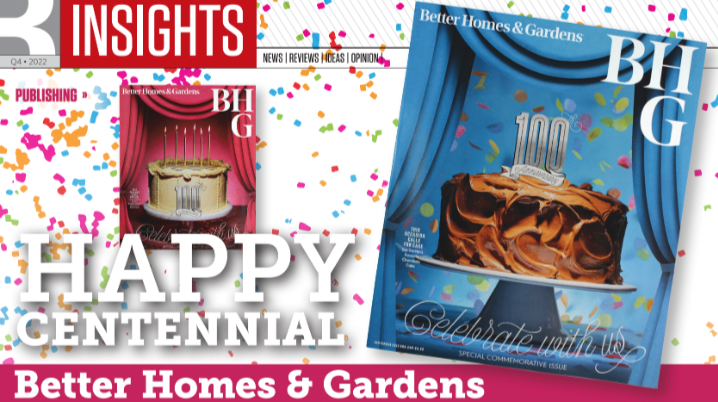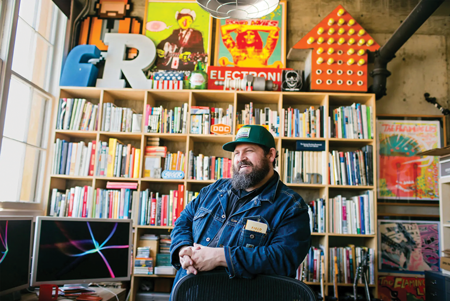A makeover might seem like an odd 100th-birthday gift. But not when the recipient is Better Homes & Gardens. For its centennial, the magazine received a redesign, complete with a new logo, a larger trim size (9″ x 10 7/8″), and an upgrade in paper stock. What’s more, four covers were created for the September 2022 anniversary issue, each featuring a showstopping cake by a celebrity chef: Ina Garten, Carla Hall, Padma Lakshmi, and Jacques Pépin.
BHG’s centennial, along with its investment in a larger size and better paper, refutes the misconception that print is dead. Rather, “the print business model is changing,” says Samir “Mr. Magazine” Husni, Founder and Director of the Magazine Media Center. “Even companies that are cutting back on magazines are putting out bookazines.” So are titles that aren’t cutting back. BHG’s recent bookazines included Flower Gardening and 5-Ingredient, 30-Minute Recipes, each with a $12.99 cover price. “We’re seeing a lot of magazines coming to the marketplace, but at higher prices,” Husni adds. “They’re no longer an impulse buy.”
Neil Vogel, CEO of BHG parent company Dotdash Meredith, said much the same at the BMO Digital Advertising Summit in March 2022. The company’s print magazines were “going to increase in quality,” he said. “It’s a little bit of a luxury experience.”
At the same time, to offset the costs of the improved paper, BHG cut circulation from 7.6 million to about 4 million, Husni says, getting rid of heavily discounted and giveaway subscriptions. “They are focusing more and more on the customers who count.”
Staying True to the Mission
On the editorial side, this focus on customers who count is a key reason BHG has made it to 100 years. Originally titled Fruit, Garden and Home, the magazine was a spin-off of Successful Farming, founded in 1902 and still going strong. For the farmers’ wives who were the original subscribers, articles included instructions on pruning fruit trees, canning, and building their own log cabins; today, articles about choosing dehumidifiers, upgrading millwork, and selecting paint colors are more typical. But what the magazine’s target audience is looking for has remained the same: suggestions for creating a better home (and garden, and lifestyle) for their families.
“I think the secret ingredient [to BHG’s longevity] is they stay true to service journalism—meeting the needs, wants, and desires of people. They offer their readers and advertisers a call to action,” Husni says. “Remaining true to the DNA of the publication is most important because everything else is going to change.” The definition of family, for instance, has evolved during the past century, but BHG “has remained in the service of the family. It’s rare in this day and age to see a magazine that can adapt to all the changes and still remain true to its mission.”
This also seems to be the secret to the success of other long-standing magazines still in print. Scientific American, launched in 1845, progressed from articles about a “combined wringer and mangler” (a forerunner to the washing machine) to pieces covering the powering down of the Voyager spacecraft, but delving into scientific and engineering advances remains its mission. Founded in 1865, The Nation continues to investigate and review news and culture, while the apparel and imagery seen in Harper’s Bazaar (founded in 1867) and Vogue (1892) today might have given their original readers the vapors. But each magazine has the same mission today as it did in the 19th century: making fashion trends (if not the couture fashions themselves) accessible to aspirational women.
The Digital Factor
Adhering to their mission while expanding into websites, social media feeds, and other digital offerings has been integral to magazines’ ability to change with the times. BHG, for instance, estimates it has 6.1 million followers on Facebook alone and 8 million monthly readers of its digital and mobile magazine versions as well as 10 million unique visitors to bhg.com each month.
Numbers like those might have led some publishers to go digital only. In fact, several sister titles of BHG, including Entertainment Weekly and InStyle, no longer produce regular print issues. Even they, however, produce bookazines such as the former’s Ultimate Guide to Stranger Things and the latter’s fall fashion and beauty roundup.
“Digital is never a replacement to print. You need digital, but it’s not a replacement,” Husni insists. For one thing, the omnipresence of digital content has led to it becoming a commodity. “If any magazine is just in the business of content providing, there’s no future for them, because anyone can get content in 140 characters online,” he says.
So, while many websites might offer, say, tips for keeping houseplants alive, BHG homes in on the plants and plant issues most common to its readers and presents them in its unique voice. Esoteric fauna and rococo language have no place here. “Its editors are not only creative but also curators,” Husni explains.
And when that curated content is delivered directly to readers in the form of a tangible magazine, one they can hold, keep, file, and easily refer to time and again, the result goes well beyond content. “You’re engaging audiences with an experience,” Husni says.“And that’s why, as long as we have human beings, we’re going to have print.”








